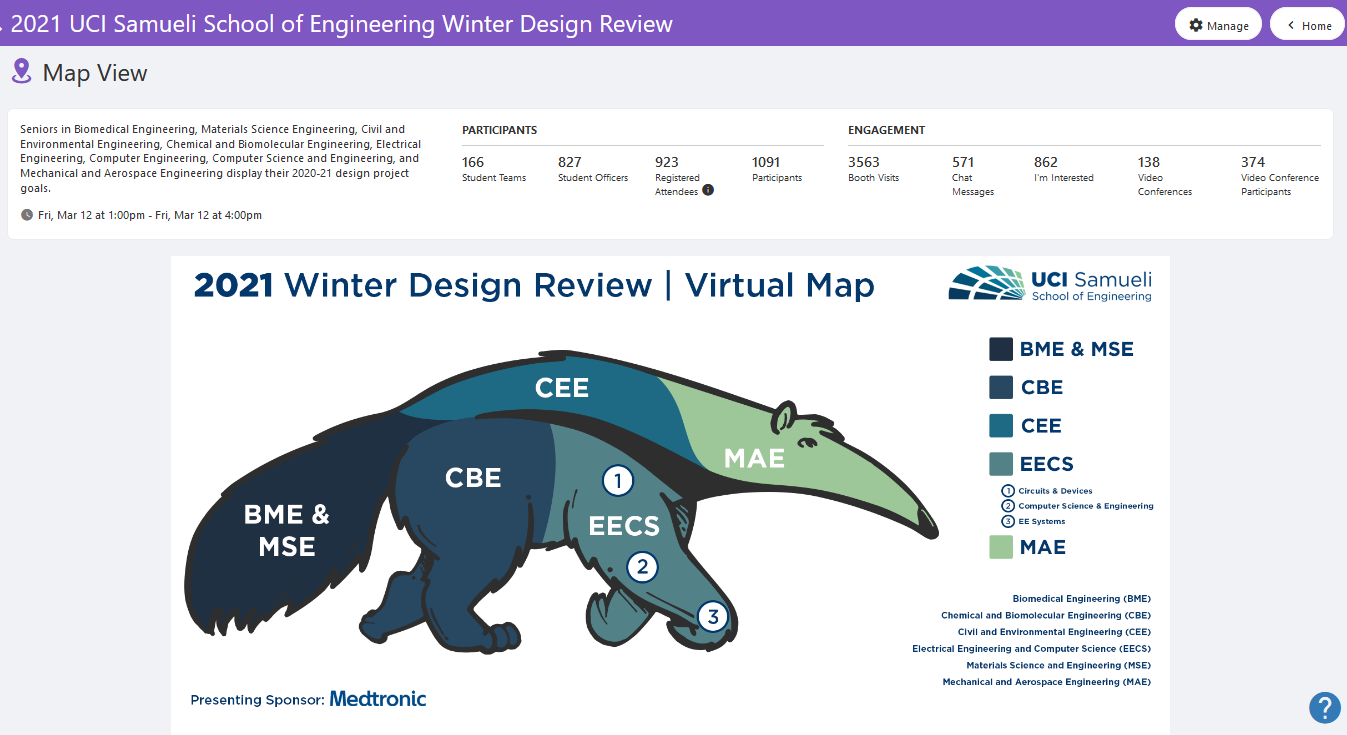
March 25, 2021 - This year’s Winter Design Review was held virtually, March 12, and as with many activities during this pandemic year, it encountered technical difficulties. After a welcome webinar from Interim Dean Michael Green, participants began logging on to start visiting some of the 166 student team project booths and video conference rooms. With more than 1,000 participants involved, including students, faculty, alumni, industry affiliates, parents and staff, the platform took a hit and crashed. However, the school’s event organizers and information technologists worked quickly to discover and resolve the issues, and soon enough, everyone was able to log on and enjoy the three-hour event.
The engineering senior design program provides students with hands-on learning experience and professional development through innovative projects that bridge academic fundamentals with real world challenges. After working on their projects for two quarters, students present their ideas by displaying or demonstrating them to a wider audience at Winter Design Review.
More than 800 students, from all six of the school’s engineering departments, completed projects and set up virtual booths, showcasing their work with posters, videos and Zoom conference rooms.
Green thanked the 150 external audience members for attending the event and acknowledged the value of industry involvement in the design projects. He also thanked and introduced this year’s presenting sponsor, Medtronic, and invited John Wainwright, the company’s director of research and technology, to say a few words.
“I’m a firm believer that these types of student projects are where innovation happens, and I look forward to seeing some great results,” said Wainwright, who also announced that the medical technology company was establishing a Medtronic Endowed Student Award in Engineering to support Samueli School undergraduate scholars.
Most of the student teams were on hand to interact with visitors via chat message or video conference. There were 3,563 booth visits, 571 chat messages and 138 video conference sessions, according to the platform’s final record. Some of the projects targeted current challenges. One mechanical and aerospace engineering team presented the Bag Sanitation System, a portable cloth bag equipped with UVC lighting, which people could use to clean items. “We envision this for working professionals,” said Wei-En Chen, team leader. “We’ve designed a bag with UVC technology to remove germs, bacteria and other viruses with safety precautions to prevent the UV rays from harming the user. This product would be beneficial even beyond the COVID-19 pandemic.”
Thirteen teams won Dean’s Choice Awards. The annual awards are based on department nominations using the following criteria: Does it solve a grand challenge problem? Can it lead to commercialization, or is viable and practical? Is it cool; what’s the wow factor?
Green announced the winners (below) and told the students: “Our world is changing so fast and the work you are doing today is critical to a better future. You will find tremendous value in the problem-solving and teamwork skills that are innate to these engineering design projects. With your Anteater engineering experience, you should know that you are well prepared for success in your future career endeavors.”
Dean’s Choice Awards
BME/MSE
BIOENGINE Edwards Femoral Access Device for Aortic Sheaths
A femoral access device using the mechanical design of a needle driver, augmented reality, blood flow simulations and clinical research.
Team members: Julian Drake (lead), Rachel Goodman, Brooke Koren, Bradley McHargue, Jasmin Morfin, Karilyn Odom
Feminora: Redesign of the Speculum
An expandable vaginal speculum for improved patient comfort and physician convenience.
Team members: Ashley Urrutia Avila (lead), Mei Jin, Madhu Kannan, Henry Nguyen, Joshua Wang
SiPhox: Agitation and Temperature Control of Sample Wells
An at-home, point-of-care device that will utilize cheap-to-manufacture photonic silicon chips to detect the presence of antigens and other biomarkers.
Team members: Heath Muskat (lead), Sherwin Eftekharian, Inkiad Ahmed, Kelsey Lawson, Adriana Mejia
Skin Buddy: Handheld Device for Skin Lesion Imaging
A hand-held device that can image skin lesions on any area of the body, for diagnostic purposes.
Team members: David Lopez Castro (lead), Madison Blampied, Donya Khashayar, Micah Lawrence, Justin Salamanca, Lindsey Thomas
CEE
Tier 5
An environmentally friendly self-sustainable research lab, with innovative technology and appealing design.
Team members: Rony Francisco Hernandez (lead), Montana Reinoehl, Alexandra Huff, Janet (Woojin) Song, Salem Okamura
EECS
Heart Beat Trackers (Remote Heart Rate Monitor)
A remote heart rate monitor that provides contactless monitoring by using a webcam.
Team members: Luis Anibal Lopez (lead), Jonathan Robert Wilson, Yoshitaka Hiramatsu, Carlos Enrique Gonzalez Castellon
RORRIM: Smart Mirror
A health-centric smart mirror that displays date, time, weather and health data to users of the Fitbit Sense tracker.
Team members: Isabelle Pinshin Wang (lead), Johnathan Tang, Bryan Dinh An Trinh, Carissa An Sevaston, Kevin Shawn Zhu
SALUS Security
An open-source security system for K-12 schools that uses affordable hardware to detect if a weapon is present and notify authorities autonomously.
Team members: Luis Enrique Ivey Jr. (lead), Dennis Manh Nguyen, Tessa Ying Shune, Brandon Nguyen Tran
WALTER: Wireless Autonomous Litter Transportation Earth Robot
A wireless autonomous robot that picks up litter.
Team members: Brandon Daowei Hsu (lead), Tommy Nguyen, Jeffrey Hoang-Duy Pham, Justin Lee
MAE
Automated Colorimetric Bioassay
A more affordable and effective malaria automated assay device.
Team members: Michael Thorne (lead), Christopher Villasenor Bojorquez, Armando Victoria, Alexander Nhat-Nam Huynh, Alexander Xavier Acosta-Alvarenga
HyperXite
This group of young engineers participates in Hyperloop competitions by developing and refining their revolutionary transportation pod prototypes.
Team members: Mahek Logantha (lead), Myron Phan, Nathan Bernardo, Leanna Hao, David Villalpando, Kaushal Patel, Rahul Sheth, Vikram Bhave, Sarah Graves, Christine Tran, Chris Wu, Robert Laviguer, Tyler Johnson, Nickolas Nepite-Temblador, Danny Nguyen, Beverly Ortiz-Ramirez, Safia Reazi, Mugared Khalifa, Adrian Ornelas, Aafreen Pattan
UCI CanSat
A satellite probe that samples air data, transmits the data to a ground station in real time and safely controls its return.
Team members: Brandon Junmin Wong (lead), Alan Nicholas Wong, Andrew Zhao, Oscar Rene Castro Jr.
UCI Rocket Project
This team designs and fabricates liquid-fueled rockets.
Team members: Jorge Karam Padilla (lead), Chris Anderson-Hickey, Matthew James Polcyn, Austin Jonathan Holm
– Lori Brandt
